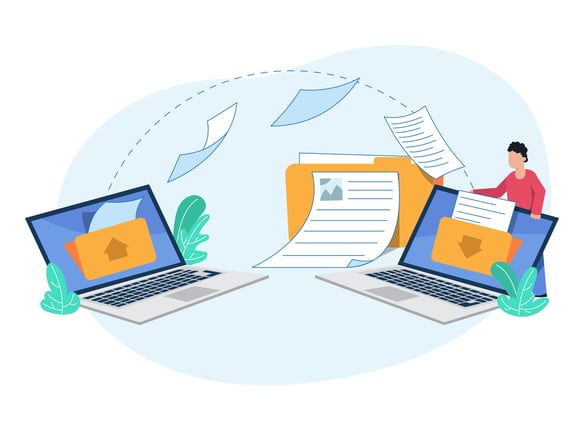Streamline Your Data Migration with e-Content Migrator
by Shrikant Wadkar, on Dec 5, 2023 3:21:54 PM
Key Take-aways:
- Data migration is essential for organizations undergoing system upgrades, data consolidation, cloud adoption, and mergers/acquisitions in the digital landscape.
- Functional (mapping, quality, volume) and technical challenges (extraction, validation, security) must be navigated with careful planning and expertise during data migration.
- The e-Content Migrator Tool automates content analysis, mapping, and data cleansing, offering efficient data migration, continuous improvement, and successful transitions like Documentum to SharePoint.
Introduction:
In today's digital landscape, data acts as fuel for every organization. Whether it's upgrading systems, consolidating scattered data, adopting the cloud, or navigating mergers and acquisitions, data migration plays an essential role in modern business operations. In this blog, we'll explore the need for data migration, the challenges it presents, and how our e-Content Migrator Tool can be your key to successful content migration.

The Need for Data Migration:
Data migration involves the transfer of data from one system, platform, or storage medium to another. This need arises for several reasons:
- System Upgrade or Replacement: The transition from old systems to new ones during upgrades or replacements requires a smooth data migration process.
- Data Consolidation: Unifying data from multiple systems into a single platform is essential for efficient operations and decision-making.
- Data Archiving: Transferring older or rarely accessed data to secondary storage or archival platforms frees up space and resources.
- Cloud Adoption: As organizations shift to the cloud, migrating data from on-premise systems becomes imperative.
- Mergers and Acquisitions: Integrating and consolidating data from different entities is a complex but vital part of business mergers or acquisitions.
Data migration demands careful planning, validation, and testing to ensure a secure and successful transfer.
Challenges of Data Migration:
Data migration poses several challenges, both functional and technical:
Functional Challenges include:
- Data Mapping and Transformation: Ensuring data compatibility between source and target systems.
- Data Quality and Cleansing: Addressing issues related to data quality, such as duplicates and inconsistencies.
- Data Volume and Complexity: Managing and transferring large volumes of data and complex data structures.
- Data Governance and Compliance: Maintaining data governance and compliance throughout the migration process.
Technical Challenges encompass:
- Data Extraction and Transfer: Efficiently moving data from one system to another.
- Data Validation and Testing: Ensuring the integrity and correctness of the migrated data.
- System Integration and Compatibility: Integrating data into the target system without disruptions.
- Downtime and Disruptions: Minimizing downtime during the migration process.
- Data Security and Protection: Ensuring data security throughout the migration process.
- Monitoring: Continuously monitoring the migration progress to identify and address issues promptly.
Overcoming these challenges demands a well-defined strategy, meticulous planning, and the expertise of experienced professionals.
Benefits of Using Our e-Content Migrator Tool:
Our e-Content Migrator Tool offers a range of benefits to streamline the content migration process:
- Automated Content Analysis: Analyzes content in the source system, extracting key metadata, which saves time compared to manual assessment.
- Content Mapping and Transformation: Assists in mapping content structures and formats, ensuring compatibility and consistency during migration.
- Data Cleansing and Enrichment: Identifies and addresses data quality issues, such as duplicates or inconsistencies.
- Automated Data Migration: Automates the transfer of content, reducing human error and improving efficiency.
- Content Validation and Testing: Validates and tests migrated content to ensure integrity and correctness.
- Continuous Improvement: Learns from the migration process and user feedback, becoming more accurate and effective over time.
- Generative AI for Configuration: Accelerates coding with automated code generation, streamlines development, and automates testing and documentation process.
Here are a few successful content migrations made possible by our e-Content Migrator Tool:
- FileNet to Sharepoint: Seamlessly migrated content from FileNet to SharePoint, enabling organizations to modernize their ECM, enhance collaboration, and ensure seamless access to critical business documents.
- FileNet Panagon Image Services to FileNet P8 Migration: Migrate documents, metadata, and user access seamlessly from legacy FileNet Image Services to a modern P8 environment. Extract and transfer document classes, properties, and repositories while ensuring data integrity, security, and minimal disruption to operations.
- Documentum to SharePoint: Seamless transfer of documents, metadata, and folder structures, maintaining data integrity and associations.
- Documentum to AWS Storage: Leveraged the tool's integration with AWS APIs to migrate files securely and optimize storage costs.
- SAP DMS to Documentum: Provided transformation capabilities for extracting documents from SAP DMS and migrating them to Documentum.
- Filestore to Documentum: Efficient transfer of files, maintenance of folder hierarchies, and integration with Documentum.
Seamless FileNet Migration: How Harris Teeter Transformed Content Management with Automation
Organizations relying on legacy ECM platforms like IBM FileNet often face challenges in maintaining performance, scalability, and integration with modern digital ecosystems. A case in point is Harris Teeter, a leading supermarket chain, which successfully transitioned from FileNet to a modern content management system using Datamatics' intelligent automation solutions. By automating document workflows and streamlining content migration, Harris Teeter enhanced operational efficiency, reduced processing time, and improved compliance. This showcases how E-Content Migrator can simplify FileNet-to-modern ECM migrations, ensuring minimal downtime and maximum data integrity.
Conclusion:
Our e-Content Migrator Tool offers robust functionality, automation, and reliability, ensuring successful content migration across platforms and systems. Its mapping, transformation, and validation capabilities simplify the process, maintain data integrity, and minimize disruptions. When it comes to data migration, trust in a tool that makes the complex seem simple - choose the e-Content Migrator for seamless and efficient content migration.
Next Reading

















